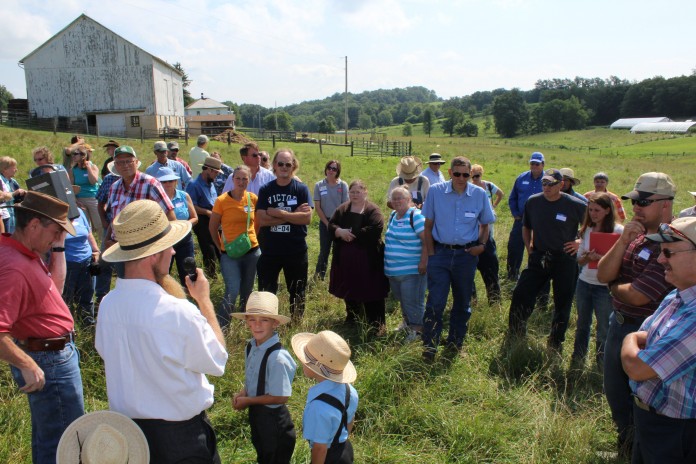CHARM, Ohio — Experienced and beginning sheep graziers were treated to an all-day tour of grazing operations in southeastern Holmes County and parts of Coshocton County July 12.
The tour began at the Raymond Yoder farm near New Bedford, where Yoder and his family raise Katahdins on a 14-acre pasture. Yoder sells lambs at the Mount Hope Auction and raises them mostly on grass.
For shelter, he uses a covered hoop-style unit, with fence panels to keep them enclosed when necessary.
His pasture possesses a good amount of ryegrass, but also is overgrown with common ragweed. Graziers on the tour said ragweed actually is highly nutritious, but only for a short period of time. It also tends to take over and choke out other, more beneficial growth.Weed control.
Bob Hendershot, retired grasslands conservationist with the Natural Resources Conservation Service, said the best thing would be to mow the ragweed, before it goes to bloom and spreads its seeds.
Another issue was over-grazing. Hendershot said the large, open pasture would do better if it were fenced off and divided into smaller sections, to control the rate at which the pasture is grazed, and allow for recovery.
Yoder had a steady-flowing water spring entering the pasture, which graziers said could be improved to provide the animals an excellent source of steady, fresh drinking water.
Hendershot said weeds are a “symptom” of what’s going on in the soil, as well as how a pasture is managed. But educators on the tour said the weeds could also be an issue from last year’s drought, which stressed some of the beneficial grasses and allowed for more weed growth.
Hendershot said producers should also think about re-seeding their pastures — especially when they’re relying on old, worn out grasses. He said Kentucky 31, for example, is a popular grass. But it dates back to 1931 and is outdated.
“The newer genetics of our grass is so much superior to our older grass,” he said. “We spend a lot of money improving the genetics of our sheep. Improve the genetics of your pasture-field.”
About fescue
The Dennis Hershberger farm — the second stop on the tour — had an abundance of fescue in the pasture, in addition to orchard grass and some others. Graziers said as a grass, fescue is about as beneficial as it is a challenge. On the beneficial side, it grows well, and especially late in the season.
But, if too much is eaten, it becomes toxic and can restrict blood flow — at worst resulting in the loss of an animal’s extremities. Hershberger and his four young boys raise Dorsets and sell them at the 60-pound range at Mount Hope Auction. They have about 12 acres in rotational grazing and try to mow it once a summer, to control growth.
He does not till his pasture and is looking at ways to make organic improvements.
Troyce Barnett, NRCS grasslands specialist, said pastures do best when they have lots of cover and no bare ground, because they stay up 20 degrees cooler and retain more moisture and soil nutrients.
Resist tillage
He said by not tilling the pasture, graziers also help keep more carbons in the soil, and out of the atmosphere.
Crops and grasses have a known ability to sequester and capture harmful carbons, but when tilled, the stored carbons are released and can lead to a buildup of carbon in the atmosphere.
“This old earth has a way of cleaning itself if we will let it,” Barnett said. “But our finger prints are all over it.”In the afternoon, the tour featured stops at the Monroe Barkman farm, and Earl Erb’s sheep farm.
Summit County residents Jim Helms and Jeannie Hill said they attended the tour to learn more about Katahdins and sheep grazing in general. They’re both 4-H advisers and said they want to expand the youth sheep program in their mostly-urban county.Helms said the more they learn on the tours, the more they can do when they go back home, to their own county.
The tour was directed by Ohio State University Extension Educator Rory Lewandowski. It was sponsored by Ohio Heartland Sheep Improvement Association, Ohio Forage and Grasslands Council, Ohio Sheep Improvement Association, and OSU Extension.(
STAY INFORMED. SIGN UP!
Up-to-date agriculture news in your inbox!



























Hello, here is a link for subscription information: https://www.farmanddairy.com/subscribe/
I would like to know when there will be another show like this pls let me know if there is one coming up this summer tky
Hello Delilah, the Ohio State University Extension and Ohio Sheep Improvement Association are great resources for upcoming sheep events. The OSIA is online. An especially good event is known as the Ohio Sheep Field Day and I believe that’s in July. The OSIA website will have more info.